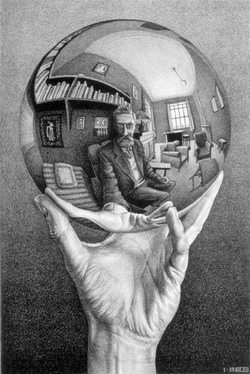Chapter 4: Perception¶
Introduction¶
This week we will delve into the deep artistic and philosophical issues that arise when we consider the phenomenon of perception. In perception, a lot of the issues that arose in the first few sessions come together: our perception generates a sense of presence (we are present in our surroundings through our perception of these surroundings); we enhance our perception with technological means (thereby becoming some kind of hybrid between biology and technology); it is through perception that we identify the things surrounding us and thereby, in a reactive way, form an idea of our own identity.
It has traditionally been the arts that showed us a way of perceiving – either by creating a world of its own (e.g. ritualistic painting, sculpture, music) or by re-creating the perceived world in another (and sometimes novel) manners (e.g. romantic or modern painting). However, in our technological contemporary world, our perception is increasingly not only aided by artificial means, but also modelled by it: the technology forces our perception in certain directions – directions that are sometimes completely different than our biological make-up would suggest.

Session¶
In this session, we will look into the embodiment of perception, as is has been elaborated by Maurice Merleau-Ponty (especially in his Phénoménology de la Perception). Merleau-Ponty is explaining his views on perception and the role painting plays in it. He encourages us to look with the eyes of Cézanne, Klee, or Matisse in order to see our natural world in a new and surprising light.
We also look at other forms of perception – there's more to perception than meets the eye. We will look into music and dance, touch, and perhaps smell.
Literature¶
Merleau-Ponty, M, 1964, l'Œil et l'esprit. Éditions Gallibard. Of this we will read §§1 and 2 (pp.9-35).
It's not the easiest piece to read, but we'll talk about it in some detail during the session.
Info
This work is easily findable online. I've provided a pdf of an English translation for easy reference.
- Hayles, N.K. (1999): How we Became Posthuman. Virtual Bodies in Cybernetics, Literature, and Informatics. University of Chicago Press, Chicago. Of this book, read her exposition of Merleau-Ponty's work on pages 199-207 (Incorporating Pracices and Embodied Knowledge).
Info
This book is readily findable though the RuG-Library, and available as e-Book by that means.